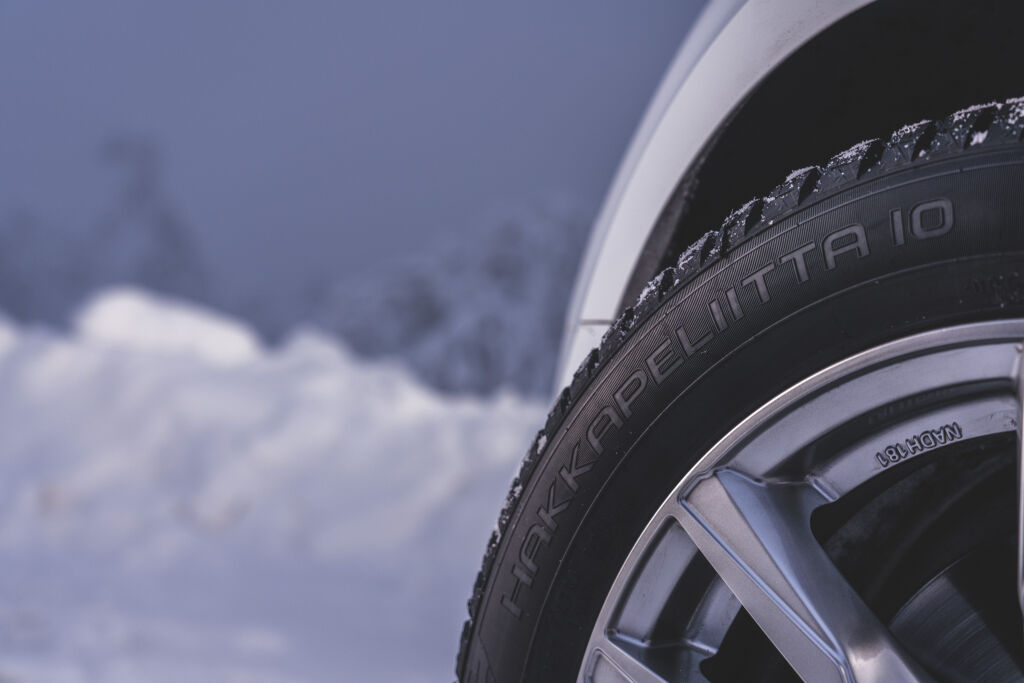
Cold weather has an effect on the air pressure of your tires. Choose the right tire pressures for winter tires and drive safely in all conditions.
The air pressure in tires affects both driving safety and the durability of the tires. Therefore, it is important to check the air pressures regularly and keep them at the level recommended by the car manufacturer. Temperature also plays a role in how your tires retain their air pressure. Take this into account especially in cold weather and adjust the pressures of winter tires to suit the freezing conditions.
Use Higher Tire Pressure in Winter
Temperature has a direct effect on tire pressures in winter: as the weather gets colder, tire pressures decrease. In passenger car tires, tire pressures drop about 0.1 bar per ten degrees of temperature. Therefore, it is recommended to maintain 0.2 bar higher air pressure in winter tires than in summer tires.
Vehicle manufacturers may already provide separate recommendations for winter and summer tire pressures. Always follow the manufacturer's recommendation when available. If no separate recommended pressure is given for winter tires, add 0.2 bar to the recommended air pressure in winter. You can find air pressure recommendations, for example:
- From the driver's side door
- From the sticker on the fuel cap
- From the vehicle's manual
- From the vehicle manufacturer's guides
Measure Tire Pressures Regularly, Especially in Cold Weather
Tire pressure decreases slightly in all conditions, and this is particularly emphasized in cold weather and fluctuating temperatures. Check your tire pressures at least once a month to keep them at the right level. Also, check tire pressures whenever you drive with a heavy load or when you are heading on a longer drive. Note that if you are driving in Europe, winter tire regulations may vary between countries.
Measure tire pressures from cold tires to get a more reliable result. Tires heat up during driving, so it's advisable to measure air pressure before driving. Preferably, measure the pressures when the car has not been driven more than a few kilometres before taking the measurements.
Also note that if you check tire pressures in a warm garage, for example, they can easily remain too low for outdoor air in winter. The temperature in the garage can be around +20 °C, and when the outdoor temperature is -10 °C, the temperature difference is already 30 °C. In this instance, the tire’s air pressure should be 0.3 bar higher.
Low Tire Pressures Cause Problems
Too low tire pressure can cause various problems for the driver. Under-inflated tires start to wear unevenly, which shortens their lifespan. Driving with under-inflated tires increases fuel consumption. Also, the steering response and driving experience suffer. from under-inflated tires.
"People often ask why tires 'bounce' when driving in severe cold temperatures. This is because the air pressures have significantly dropped in the cold, and the tire has frozen or cooled down, leaving a permanent dent. The tire loses its shape and is non-round until it properly warms up. It's advisable to favor a slight overpressure to avoid these problems," says Matti Morri, Head of Technical Customer Service at Nokian Tyres.
Too low pressures also lengthen the braking distance and increase the risk of aquaplaning. In the demanding winter driving conditions, it is especially important to take care of safety features. When you adjust the pressures of winter tires to the right level, you drive safely and save on fuel costs. At the same time, the lifespan of the tire set is extended. Proper storage of tires also extends their lifespan - so store your winter tires over the summer in a dry, cool, and light-protected space.

Check Tire Condition
Your winter tires wear evenly when their air pressure is at the recommended level. You can monitor tire wear by measuring tread depth. The tires can better direct slush from the road when the tread depth is greater. The driving tires of your vehicle typically wear slightly faster than freely rotating tires. For this reason, those who drive a lot should rotate their tires under the vehicle as needed to even out wear. When the tires start to become too worn, it's time to buy a new set of winter tires.
By law, the tread depth of winter tires must be at least 3 mm, depending on the country. However, the safety features of the tires have already significantly deteriorated when reaching the minimum limits. Purchase new winter tires at the latest when they have worn to the 4 mm mark. If you use studded tires in winter, monitor the condition and quantity of the studs in addition to tread depth:
"Today, the winter season does not automatically mean that there will always be snow or ice on the roads. When driving on dry asphalt in winter, the studs can easily wear more than the rubber around them. This then weakens the grip of the tire, especially on ice. When the weather gets colder, and there is snow and ice on the roads, worn and detached studs can backfire. This makes controlling the car on a slippery surface more difficult.", Morri explains.
If the number of studs varies by more than 25 percent between tires, it's time to buy new winter tires. For example, Nokian Tyres Hakkapeliitta 10 studded tires offer extreme safety even in demanding situations.
Drive Safely Throughout the Winter
Tires must be in good condition to drive safely. Keep your tires in good condition longer with these tips:
- Check air pressures regularly. Measure the air pressure from cold tires and raise the pressures by 0.2 bar in winter.
- Drive predictably and calmly. Avoid unnecessary sudden braking, sudden acceleration and aggressive steering movements.
- Store tires properly. Tires will not deteriorate when stored in a dark, dry, and well-ventilated space. Check air pressures after seasonal storage.
Driving in winter can be unpredictable due to demanding conditions. Therefore, taking care of air pressure and tire condition is particularly important. Remember to check the condition of your tires and buy new tires when their safety features start to deteriorate. This way, you'll drive securely and steadily in all conditions.
Please remember that it is the driver’s responsibility to ensure their tires are safe and suitable for their vehicle and to follow the vehicle’s manufacturer´s guidelines for proper use and maintenance. Consult your closest Nokian Tyres dealer or your vehicle’s manufacturer for specific advice.


